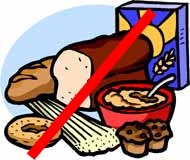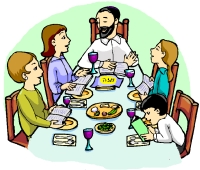There are three main customs connected with Pesach. One of these is eating matzah. The second is that we are not allowed to eat or own anything made of leaven (grains which have risen). This is known as chametz. The third custom is having the Seder.
 MATZAH
MATZAH
Matzah is unleavened bread made from wheat, rye, barley, oats or spelt. It is a mitzvah (commandemnt) to eat matzah during Pesach.
Matzah is also known as ‘the bread of affliction’. ‘Affliction’ means ‘hardship’, and so matzah represents the difficulty of our lives in Egypt before we escaped.
CHAMETZ
We are not allowed to eat anything made of chametz (‘leaven’). Meat, fish, fowl (chicken, duck, etc.), all fruits, all vegetables, all spices, dairy products and, of course, matzah are not chametz and may be eaten during Pesach. Matzah is not chametz because it is mixed and baked very quickly before the flour in it has time to rise and become leaven.
Any one of the ‘five grains’ – wheat, rye, barley, oats and spelt (a type of red wheat) – can become chametz if it is mixed with liquid for long enough for it to rise or ‘leaven’. Any food that contains even the tiniest amount of chametz is forbidden during Pesach.
We must completely clean our homes before Pesach starts, and get rid of any food that has chametz. Dishes, pots and pans that were used for chametz are either stored away for Pesach or go through a very strict cleaning process called kashering so that they may be used on Pesach. This is because we avoid even the tiniest trace of chametz during Pesach.
On the night before Pesach we perform Bedikat Chametz, the ‘search for leaven’. This is a symbolic search of the house by candle light looking for any remaining chametz. Any remaining chametz (some is always left out deliberately to be found) is swept up with a feather and will be burned on the morning before Pesach to symbolise that we are ridding ourselves of all our chametz.
SEDER
The Hebrew word ‘seder’ means ‘order’. We eat a special meal on the first two nights of the festival (but only on the first night if in Israel). We read about the story of Pesach in the haggadah (a special book read only at the Seder) and we eat a meal which includes many special foods with symbolic meanings to remind us better of the Pesach story.
Video
The song Mah Nishtanah (‘How is this Night Different?’) is sung at the Seder and is usually sung by a young child or children (if no children are present, then it is usually sung by the youngest person present).




